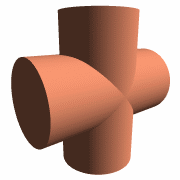Love Calculus?, Try this!
There are two circles:
- with equation
- with the equation .
revolves with as the axis while revolves with as the axis.
What is the total volume of the solid structure formed by the revolution of two circles?

Clarification and Caveat: The Structure will have more than one Steinmetz solid , so be carefull while entering your answer. And correct your answer to three decimal places. Assume the ring shaped structure formed by each circle to be a perfect cylinder.
This problem is original.
The answer is 2147.903.
This section requires Javascript.
You are seeing this because something didn't load right. We suggest you, (a) try
refreshing the page, (b) enabling javascript if it is disabled on your browser and,
finally, (c)
loading the
non-javascript version of this page
. We're sorry about the hassle.
Since both the circles have the same radii= 2 and are at equal distance from the origin (i.e.)= 1 0 2
Both will have the same volume of revolution .
Calculating for one revolution=Area of the circle × the length traversed by its center ( 2 × π × 1 0 2 )
We get = π × 2 2 × ( 2 × π × 1 0 2 ) = 1 1 1 6 . 6 1 8 2 7 2
The volume due to revolution of other circle will be same, so total volume formed= 2 × 1 1 1 6 . 6 1 8 2 7 2 = 2 2 3 3 . 2 3 6 5 4 4
Now, there will be t w o Steinmetz solid(Bi cylinder) , one at Z > 0 and other one at Z < 0 .
Formula for Volume of a S t e i n m e t z B i C y l i n d e r (only in case of the intersecting cylinders have equal radii)= 3 1 6 × r 3 = 3 1 6 × 2 3 = 3 1 2 8
Volume of two S t e i n m e t z B i C y l i n d e r = 2 × 3 1 2 8 = 3 2 5 6
Subtracting this from total volume, we get = 2 2 3 3 . 2 3 6 5 4 4 − 3 2 5 6 = 2 1 4 7 . 9 0 3